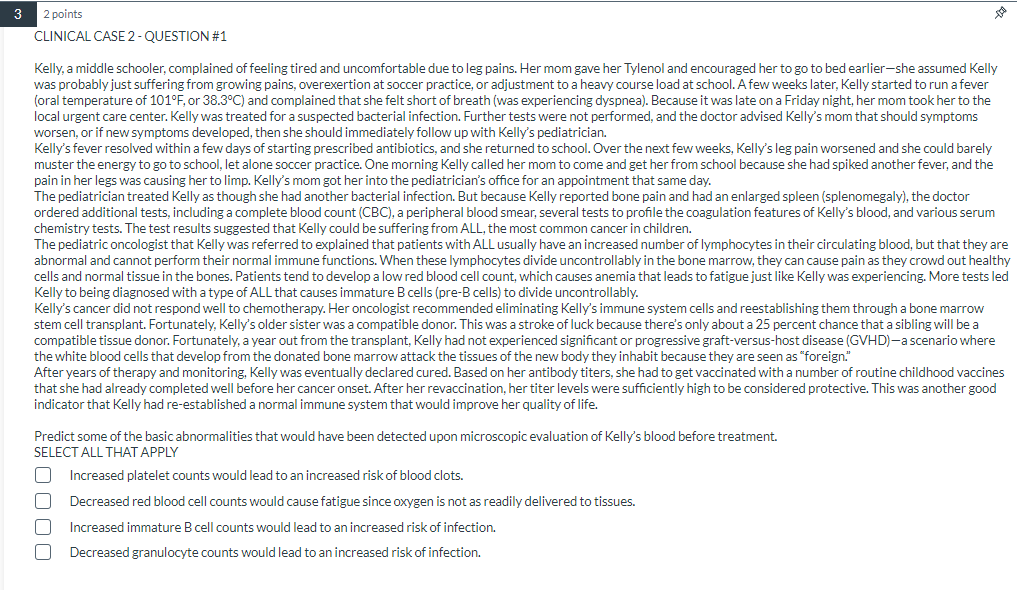Home /
Expert Answers /
Biology /
3-2-points-clinical-case-2-question-1-kelly-a-middle-schooler-complained-of-feeling-tired-and-pa815
(Solved): 3 2 points CLINICAL CASE 2 - QUESTION #1 Kelly, a middle schooler, complained of feeling tired and ...
3 2 points CLINICAL CASE 2 - QUESTION #1 Kelly, a middle schooler, complained of feeling tired and uncomfortable due to leg pains. Her mom gave her Tylenol and encouraged her to go to bed earlier-she assumed Kelly was probably just suffering from growing pains, overexertion at soccer practice, or adjustment to a heavy course load at school. A few weeks later, Kelly started to run a fever (oral temperature of 101°F, or 38.3°C) and complained that she felt short of breath (was experiencing dyspnea). Because it was late on a Friday night, her mom took her to the local urgent care center. Kelly was treated for a suspected bacterial infection. Further tests were not performed, and the doctor advised Kelly's mom that should symptoms center. Kem ests wer worsen, or if new symptoms developed, then she should immediately follow up with Kelly's pediatrician. oped, the Kelly's fever resolved within a few days of starting prescribed antibiotics, and she returned to school. Over the next few weeks, Kelly's leg pain worsened and she could barely Nelly Steven reso prescribed antibiotics, and selected to school. Over muster the energy to go to school, let alone soccer practice. One morning Kelly called her mom to come and get her from school because she had spiked another fever, and the pain in her legs was causing her to limp. Kelly's mom got her into the pediatrician's office for Panwas coas e co pediatric Home appointment that same day. mesto at opp The pediatrician treated Kelly though she had another bacterial infection. But because Kelly reported bone pain and had an enlarged spleen (splenomegaly), the doctor ordered additional tests inclu gangenen amisccion reported bor ordered additional tests, including a complete blood count (CBC), a peripheral blood smear, several tests to profile the coagulation features of Kelly's blood, and various serum de comple cod count preradio smearseverancesca co chemistry tests. The test results suggested that Kelly could be suffering from ALL, the most common cancer in children. tric oncologist that Volly referred to explained that The pediatric oncologist that Kelly was referred to explained that patients with ALL usually have an increased number of lymphocytes in their circulating blood, but that they are me pediatric onicolos arform their normal immune fuations When the usually have amincreased abnormal and cannot perform their normal immune functions. When these lymphocytes divide uncontrollably in the bone marrow, they can cause pain as they crowd out healthy colle and normal time in the honor Datinte tend to is. Whendese lymphocytes divide uncontrollably cells and normal tissue in the bones. Patients tend to develop a low red blood cell count, which causes anemia that leads to fatigue just like Kelly was experiencing. More tests led Yollu to being dired with le causes and Kelly to being diagnosed with a type of ALL that causes immature B cells (pre-B cells) to divide uncontrollably. Volledigenosed with a type divide uncondonably. roncologist recommen nemy a cance Kelly's cancer did not respond well to chemotherapy. Her oncologist recommended eliminating Kelly's immune system cells and reestablishing them through a bone marrow spond w apy.Hier oncologi recommended matins helly stem cell transplant. Fortunately, Kelly's older sister was a peet was compatible tissue donor. Fortunately, a year out from the trpatible donor. This was a stroke of luck because there's only about a 25 percent chance that a sibling will be a POHY transplant, Kelly had not experienced significant or progressive graft-versus-host disease (GVHD)-a scenario where the white blood cells that develop from the donated bone marrow attack the tissues of the new body they inhabit because they are seen as "foreign." After years of therapy and monitoring, Kelly was eventually declared cured. Based on her antibody titers, she had to get vaccinated with a number of routine childhood vaccines that she had already completed well before her cancer onset. After her revaccination, her titer levels were sufficiently high to be considered protective. This was another good indicator that Kelly had re-established a normal immune system that would improve her quality of life. Predict some of the basic abnormalities that would have been detected upon microscopic evaluation of Kelly's blood before treatment. SELECT ALL THAT APPLY Increased platelet counts would lead to an increased risk of blood clots. Decreased red blood cell counts would cause fatigue since oxygen is not as readily delivered to tissues. Increased immature B cell counts would lead to an increased risk of infection. Decreased granulocyte counts would lead to an increased risk of infection. 0000
Expert Answer
Question Answer 2) decreased RBC counts would cause fatigue since oxygen is not as readily deliver to tissue 3) incr
